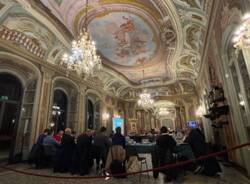A scenic tour of the Castelseprio-Torba site
This is one of the projects contained in the new 2022-2027 management plan of the UNESCO serial site “The Longobards in Italy. Places of Power.” A link between the castrum, on the hill, and the Monastery of Torba, on the valley floor, is planned.
A few days ago, the new “2022-2027 Management Plan” for the UNESCO serial site “The Longobards in Italy. Places of Power (568-774 AD)”, was presented, which gathers the most significant architectural and artistical evidence of the Longobard civilisation at the height of its historical development, which is distributed over 7 areas in 5 different Italian regions, including the Castrum with the Tower of Torba and the Church of Santa Maria Foris Portas in Castelseprio-Torba, where a scenic tour is going to be organised that will be provided with a link between the castrum at the top of the hill and the Monastery of Torba, on the valley floor, as part of a broader intervention that will include the archaeological site in the network of paths in the Medio Olona Valley.
Ten years after the inclusion, on 25 June 2011, of the serial site “The Longobards in Italy. Places of Power (568-774 AD)” in the UNESCO World Heritage List, the Associazione Italiana Langobardorum, which manages the “network site”, has started the process of redefining and upgrading the existing Management Plan. The introduction of a new management tool aims to give a new boost to the Association’s work, especially in relation to implementing the activities aimed at the socio-economic growth of the territories that contain the monumental evidence of the Longobard civilisation in Italy, from both a cultural (aimed at the knowledge, conservation, awareness-raising and promotion of the site), and a tourist point of view.
“There are going to be 18 interventions and activities involving the Castelseprio-Torba site,” said Sara Matilde Masseroli, a technician with the Ministry of Culture, and delegate of the Mayor of Castelseprio, Silvano Martelozzo, and of the Mayor of Gornate Olona, Paolino Fedre. Masseroli also highlighted “the important collaboration with research institutes, with the activities of Milan’s Catholic University of the Sacred Heart and the interuniversity project, which has just been started by the universities of Padova and Chieti-Pescara, which will certainly lead to a significant improvement in the knowledge of the ancient site, with important consequences on the plan to encourage the general public to use the archaeological site. The highlight of the initiatives to be implemented is the ambitious project to redevelop the landscape and improve the forest waterways and terrain of the entire hill on which the ancient Castelseprio lies, which started thanks to the collaboration of all subjects involved in managing the site with the Pineta Regional Park; this intervention includes, among other things, the creation of scenic tours and an equipped path that links the castrum on the hill to the Monastery of Torba on the valley floor, and will incorporate the archaeological site into the network of cycle and pedestrian paths of the Medio Olona Valley, which will clearly have positive effects also on the tourist plan and on promotion of the territory.”
“The work of updating the Management Plan, which is a guide and a constant point of reference for the protection and enhancement of such a complex serial site, like that of the Longobards in Italy, involving several individuals, was done with a view to achieving the widest possible involvement,” said Antonella Tartaglia Polcini, the President of the Associazione Italia Langobardorum. “Drawing up a Management Plan entails examining the forces and subjects present in the territory, in the cultural field and in the socio-economic and tourism field. We did it by involving various stakeholders, not only the authorities that are already formally part of the management structure, but also the local communities and the many different subjects that have been involved over time in contacts and collaborations with the Associazione Italia Langobardorum. The strategies to adopt to guarantee the enhancement and promotion of the serial site, working as a network and individually, were established to enable the various bodies, which may be distant from each other, to coordinate, with a common vision and shared goals.”
In order to identify and collect the contents, which were then used to draft the new management plan of the UNESCO site, in December 2020, a Longobard digital marathon was organised, a genuine hackathon, which actively involved the various local stakeholders with the aim of identifying worthwhile future planning abilities and strategies.
The new Management Plan is divided into 13 network projects that involve the seven territories of the UNESCO site around the country and numerous local projects, for a total of 126 projects, which focus on five themes: improving infrastructure, with the creation of new routes, and increasing accessibility to the monuments; the spreading of history, culture and intangible heritage, by organising meetings and conferences; setting-up communication plans and exhibitions in national and international venues to raise awareness and spread knowledge of the Longobard civilisation; collaborating with schools, universities and research institutes, organising teaching workshops and promoting study activities of the sites; conservation and enhancement interventions of the core zone, with the necessary planning of maintenance and restoration work on the sites; enhancement interventions of the buffer zone and socio-economic planning.
The Associazione Italia Langobardorum
The Associazione Italia Langobardorum, (which was formally established in 2009 by the Municipalities of Benevento, Brescia, Campello sul Clitunno (near Perugia), Castelseprio (near Varese), Gornate Olona (near Varese), Cividale del Friuli (near Udine), Monte Sant’Angelo (near Foggia), Spoleto (near Perugia) and the Ministry of Cultural Heritage and Activities) is the organisation that manages the UNESCO site. It is a non-profit organisation and deals with setting up, coordinating and monitoring the network actions related to enhancing, promoting and raising awareness of the UNESCO site. In this regard, protecting, conserving and enhancing the cultural heritage, raising awareness of the local communities and promoting socio-economic development are the main goals pursued by the Association, with the support of local coordination offices established by the founding municipalities and also through partnerships with public and private entities, to expand and develop the “Longobard network”, on an organised course of interactions with the stakeholders of the territories.
The UNESCO serial site of the Longobard civilisation includes: the area of Gastaldaga and the episcopal building in Cividale del Friuli (near Udine), the Sanctuary of Saint Michael in Monte Sant’Angelo (near Foggia), the monumental area with the Monastery of San Salvatore-Santa Giulia in Brescia, the castrum with the Tower of Torba and the Church of Santa Maria Foris Portas in Castelseprio-Torba (near Varese), the Basilica of San Salvatore in Spoleto (near Perugia), the Tempietto del Clitunno in Campello sul Clitunno (near Perugia) and the building complex of Santa Sofia in Benevento.
Translated by Camilla Tofanelli and Nicole Dall’Osto
La community di VareseNews
Loro ne fanno già parte
Ultimi commenti
Marco Mira su Lombardia, da ottobre nuove limitazioni per i veicoli Euro 5: divieti nelle città con più di 30mila abitanti
Maw1969 su Mia madre derubata in piazza Monte Grappa a Varese: attenzione i borseggiatori non sono solo in tv
Felice su Blitz antidroga a Tradate, circondate cinque case: un arresto e quattro indagati. Trovato un chilo di stupefacenti
Felice su Andiamo a votare
Nicpan su Andiamo a votare
Nicpan su Andiamo a votare
















Accedi o registrati per commentare questo articolo.
L'email è richiesta ma non verrà mostrata ai visitatori. Il contenuto di questo commento esprime il pensiero dell'autore e non rappresenta la linea editoriale di VareseNews.it, che rimane autonoma e indipendente. I messaggi inclusi nei commenti non sono testi giornalistici, ma post inviati dai singoli lettori che possono essere automaticamente pubblicati senza filtro preventivo. I commenti che includano uno o più link a siti esterni verranno rimossi in automatico dal sistema.